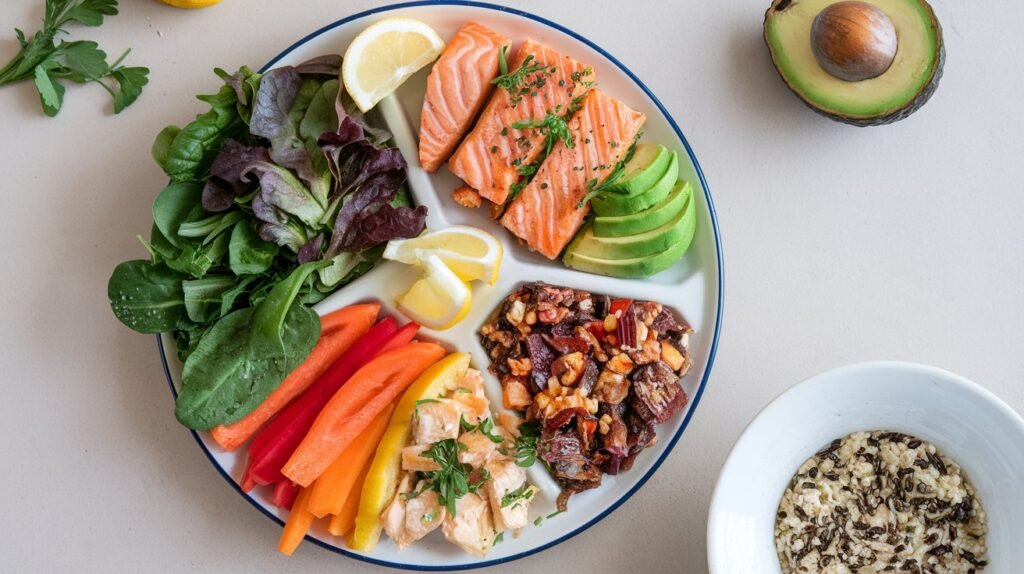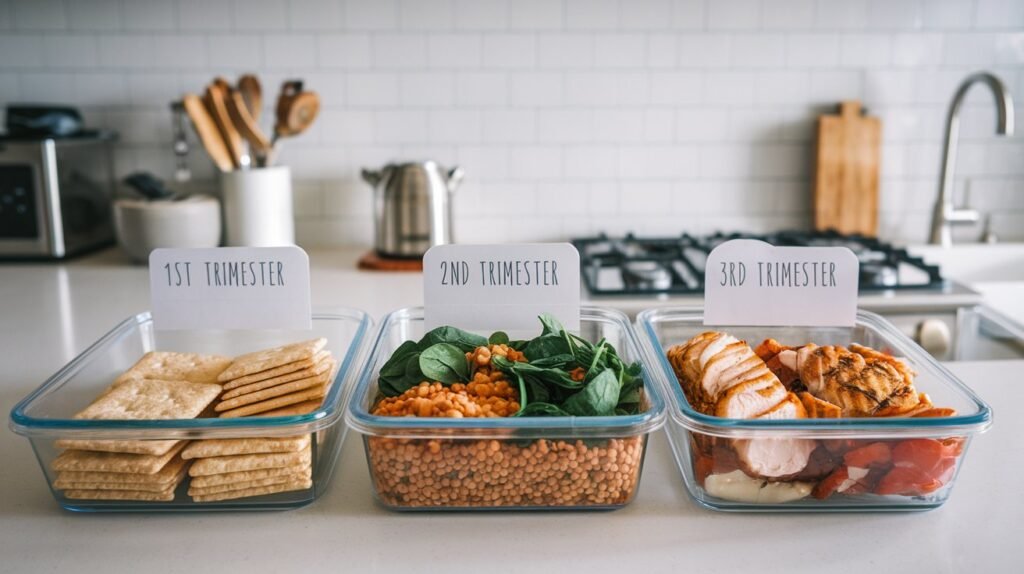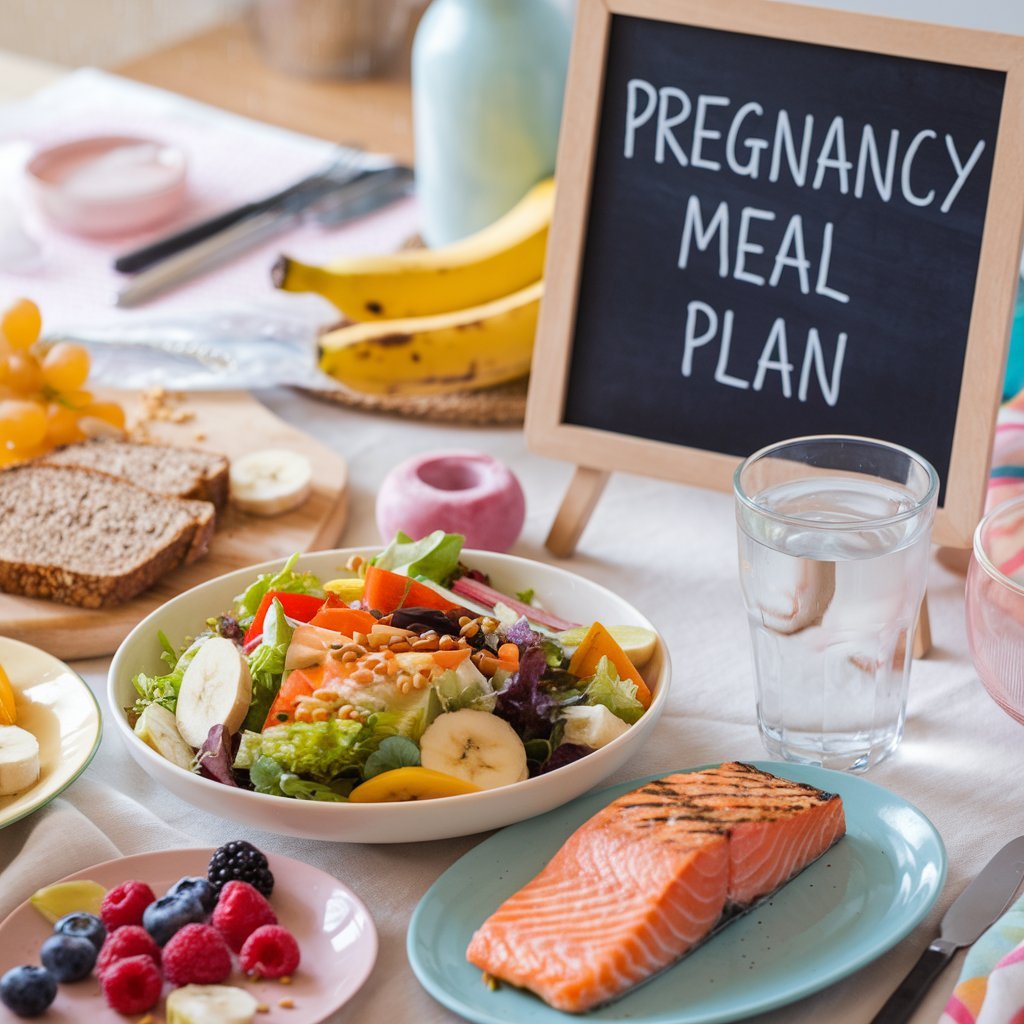Introduction to Pregnancy Meal Plan
Pregnancy is a transformative journey, filled with excitement, anticipation, and, let’s be honest, a fair share of challenges. One of the most important aspects of this journey? Nutrition. What you eat during pregnancy doesn’t just fuel your body—it also plays a critical role in your baby’s growth and development. But with so much information out there, how do you know what to eat, what to avoid, and how to create a meal plan that works for you?
Whether you’re dealing with morning sickness, navigating cravings, or simply trying to ensure you’re getting the right nutrients, this guide is here to help. We’ll break down the essentials of a pregnancy meal plan, from key nutrients to practical tips for each trimester, so you can feel confident and empowered in your choices. Let’s dive in and explore how you can nourish yourself and your baby for a healthy, happy pregnancy.
Table of Contents
Pregnancy Meal Plan
Importance of a Pregnancy Meal Plan
When you’re pregnant, every bite you take matters. But why is a pregnancy meal plan so crucial? Simply put, it’s not just about eating for two—it’s about eating right for two. A well-thought-out meal plan ensures you’re getting the nutrients your body needs to support your baby’s growth while keeping you healthy and energized. Let’s break it down.
Supporting Maternal Health and Fetal Development
Your body is working overtime to grow a tiny human, and that requires extra care. A pregnancy meal plan helps you:
- Fuel your body with the right nutrients to maintain energy levels.
- Support your baby’s development, from brain growth to bone formation.
- Reduce the risk of complications like gestational diabetes or preeclampsia.
Think of it as laying the foundation for a healthy pregnancy and a thriving baby.
Managing Pregnancy Symptoms Through Nutrition
Let’s face it—pregnancy isn’t always smooth sailing. From morning sickness to heartburn, your body can throw some curveballs. But did you know that what you eat can help ease these symptoms? For example:
- Small, frequent meals can combat nausea.
- Fiber-rich foods can alleviate constipation.
- Hydrating foods like fruits and veggies can reduce bloating.
A meal plan tailored to your needs can make those nine months a little more comfortable.
Preventing Nutritional Deficiencies and Complications
Pregnancy increases your need for certain vitamins and minerals, like folic acid, iron, and calcium. Without a proper meal plan, you might miss out on these essentials, leading to:
- Fatigue from low iron levels.
- Weak bones from insufficient calcium.
- Neural tube defects from a lack of folic acid.
By planning your meals, you can ensure you’re meeting these nutritional requirements and safeguarding both your health and your baby’s.
A Meal Plan That Works for You
Creating a pregnancy meal plan isn’t about strict rules or deprivation—it’s about balance and flexibility. It’s about finding what works for your lifestyle, preferences, and unique needs. Whether you’re a busy mom-to-be or someone who loves cooking, a meal plan can be your secret weapon for a healthier, happier pregnancy.
So, are you ready to take control of your nutrition and give your baby the best start possible? Let’s move on to the key nutrients you’ll want to include in your pregnancy meal plan.
Key Nutrients for a Healthy Pregnancy
When it comes to pregnancy nutrition, not all foods are created equal. Your body has unique needs during this special time, and certain nutrients take center stage. But what exactly should you be focusing on, and why? Let’s explore the essential nutrients that support both your health and your baby’s development.
Folic Acid and Iron for Baby’s Growth
Folic acid and iron are like the dynamic duo of pregnancy nutrition. Here’s why they’re so important:
- Folic acid helps prevent neural tube defects, which affect the baby’s brain and spine. Aim for at least 400–600 mcg daily.
- Sources: Leafy greens, citrus fruits, fortified cereals, and beans.
- Iron supports the increased blood volume in your body and helps deliver oxygen to your baby.
- Sources: Lean meats, spinach, lentils, and iron-fortified grains.
Pro tip: Pair iron-rich foods with vitamin C (like oranges or bell peppers) to boost absorption!
Calcium and Vitamin D for Strong Bones
Your baby’s bones and teeth are forming, and they need plenty of calcium and vitamin D to grow strong.
- Calcium ensures your baby’s skeletal development while protecting your own bone health.
- Sources: Dairy products, almonds, tofu, and fortified plant-based milk.
- Vitamin D helps your body absorb calcium and supports immune function.
- Sources: Sunlight, fatty fish, egg yolks, and fortified foods.
Aim for 1,000 mg of calcium and 600 IU of vitamin D daily to keep those tiny bones sturdy.
Omega-3 Fatty Acids for Brain Development
Omega-3s, particularly DHA, are crucial for your baby’s brain and eye development.
- Benefits: Supports cognitive function and may even improve your baby’s vision.
- Sources: Fatty fish (like salmon), walnuts, chia seeds, and flaxseeds.
If you’re not a fan of fish, consider a high-quality prenatal DHA supplement after consulting your doctor.
Protein for Tissue and Cell Repair
Protein is the building block of life, and during pregnancy, it’s essential for:
- Growing your baby’s tissues and organs.
- Supporting the expansion of your uterus and placenta.
- Sources: Lean meats, eggs, beans, Greek yogurt, and quinoa.
Aim for around 70–100 grams of protein per day, depending on your weight and activity level.
Don’t Forget the Basics: Hydration and Fiber
While not technically nutrients, staying hydrated and eating fiber-rich foods are just as important:
- Water helps form the placenta and amniotic fluid. Aim for 8–10 glasses daily.
- Fiber keeps digestion smooth and prevents constipation, a common pregnancy woe.
- Sources: Whole grains, fruits, vegetables, and legumes.
By focusing on these key nutrients, you’re not just eating—you’re nourishing. You’re giving your baby the best possible start while taking care of yourself. Ready to put it all together? Let’s move on to building a balanced pregnancy meal plan that works for you!
Building a Balanced Pregnancy Meal Plan

Creating a pregnancy meal plan might sound overwhelming, but it doesn’t have to be. Think of it as a roadmap to nourishing both you and your baby—one that’s flexible, practical, and tailored to your needs. So, how do you build a meal plan that’s both balanced and enjoyable? Let’s break it down step by step.
Incorporating Whole Foods and Fresh Produce
Whole foods are the foundation of a healthy pregnancy diet. They’re packed with nutrients, free from unnecessary additives, and easy to incorporate into your daily routine. Here’s how to make them a staple:
- Fill half your plate with fruits and veggies: They’re rich in vitamins, minerals, and fiber.
- Examples: Spinach, berries, sweet potatoes, and broccoli.
- Choose whole grains: They provide sustained energy and help regulate digestion.
- Examples: Brown rice, quinoa, oats, and whole-grain bread.
Pro tip: Shop seasonal produce for maximum flavor and nutrition!
Balancing Macronutrients (Carbs, Proteins, Fats)
A balanced meal plan includes the right mix of macronutrients to keep you energized and satisfied. Here’s how to strike the perfect balance:
- Carbohydrates: Your body’s primary energy source. Opt for complex carbs like whole grains and starchy veggies.
- Protein: Essential for growth and repair. Include a source of protein in every meal, such as eggs, beans, or lean meats.
- Healthy fats: Support brain development and hormone production. Add avocado, nuts, or olive oil to your meals.
Aim for a plate that’s roughly 50% veggies, 25% protein, and 25% whole grains, with a sprinkle of healthy fats.
Hydration Tips for Expecting Mothers
Staying hydrated is just as important as eating well. Water helps form the placenta, amniotic fluid, and even your baby’s cells. Here’s how to stay on top of your hydration game:
- Carry a water bottle: Keep it with you at all times as a reminder to sip throughout the day.
- Infuse your water: Add slices of lemon, cucumber, or mint for a refreshing twist.
- Eat hydrating foods: Foods like watermelon, cucumbers, and oranges can boost your fluid intake.
Aim for at least 8–10 glasses of water daily, and more if you’re active or in a hot climate.
Safe Snacking Ideas for Cravings
Let’s be real—pregnancy cravings are a thing. The key is to satisfy them in a way that’s both delicious and nutritious. Try these smart snacking ideas:
- Sweet cravings: Pair Greek yogurt with fresh fruit or a handful of dark chocolate chips.
- Salty cravings: Opt for air-popped popcorn or a small handful of nuts.
- Crunchy cravings: Dip carrot sticks or whole-grain crackers into hummus or guacamole.
Snacking isn’t just about cravings—it’s also a great way to keep your energy levels stable throughout the day.
Meal Prepping for Busy Moms-to-Be
If you’re juggling work, family, or other responsibilities, meal prepping can be a lifesaver. Here’s how to make it work:
- Plan ahead: Dedicate an hour or two each week to prep meals and snacks.
- Keep it simple: Focus on easy recipes with minimal ingredients.
- Store smart: Use portioned containers to grab-and-go during busy days.
A little preparation can save you time, reduce stress, and ensure you’re eating well even on your busiest days.
By building a balanced pregnancy meal plan, you’re setting yourself up for success. It’s not about perfection—it’s about making choices that nourish you and your baby. Ready to take it a step further? Let’s explore how your meal plan can evolve with each trimester!
Meal Planning Tips for Each Trimester
Pregnancy is a journey with distinct phases, and your nutritional needs evolve as your baby grows. What works in the first trimester might not cut it in the third, and that’s okay! Tailoring your meal plan to each trimester can help you stay energized, manage symptoms, and support your baby’s development. Let’s dive into trimester-specific tips to keep you and your little one thriving.

First Trimester: Combating Nausea with Small, Frequent Meals
The first trimester can be tough, especially if morning sickness is on the menu. But with a few smart strategies, you can navigate this phase like a pro:
- Eat small, frequent meals: Large meals can trigger nausea, so opt for smaller portions every 2–3 hours.
- Focus on bland, easy-to-digest foods: Think crackers, toast, bananas, and rice.
- Stay hydrated: Sip water, herbal teas, or ginger ale throughout the day to prevent dehydration.
Pro tip: Keep snacks like plain crackers or nuts by your bed to nibble on before getting up in the morning.
Second Trimester: Boosting Energy with Nutrient-Dense Foods
By the second trimester, many moms-to-be find their energy returning—yay! This is the perfect time to focus on nutrient-dense foods that fuel both you and your growing baby:
- Load up on iron-rich foods: Your blood volume is increasing, so include lean meats, beans, and spinach in your meals.
- Add healthy fats: Avocado, nuts, and seeds provide energy and support brain development.
- Don’t skip protein: Aim for a source of protein in every meal to support tissue growth.
This is also a great time to experiment with new recipes and flavors, as your appetite may be more stable.
Third Trimester: Preparing for Labor with Iron-Rich Foods
As you approach the finish line, your baby is growing rapidly, and your body is preparing for labor. Here’s how to adjust your meal plan for the final stretch:
- Prioritize iron: Low iron levels can lead to fatigue, so include foods like red meat, lentils, and fortified cereals.
- Ease digestion: With less room in your stomach, opt for smaller, more frequent meals and focus on fiber-rich foods to prevent constipation.
- Stay hydrated: Swelling is common in the third trimester, but drinking plenty of water can actually help reduce it.
Pro tip: Incorporate omega-3-rich foods like salmon or chia seeds to support your baby’s brain development during this critical phase.
Snack Smart Throughout Your Pregnancy
No matter the trimester, smart snacking can keep your energy levels stable and cravings in check. Here are some trimester-friendly snack ideas:
- First trimester: Ginger snaps, plain popcorn, or a handful of almonds.
- Second trimester: Apple slices with peanut butter, Greek yogurt with granola, or a hard-boiled egg.
- Third trimester: Hummus with veggie sticks, a smoothie with spinach and banana, or a small handful of trail mix.
Listen to Your Body
While these tips are a great starting point, remember that every pregnancy is unique. Pay attention to your body’s signals and adjust your pregnancy meal plan. If you’re unsure, don’t hesitate to consult your healthcare provider for personalized advice.
By tailoring your meal plan to each trimester, you’re not just eating—you’re thriving. Ready to explore what foods to avoid during pregnancy? Let’s keep the momentum going!
Foods to Avoid During Pregnancy
When you’re pregnant, what you don’t eat can be just as important as what you do. While it might feel like there’s a long list of “no-nos,” these guidelines are designed to keep you and your baby safe. Let’s walk through the key foods and beverages to avoid during pregnancy, why they’re off-limits, and what you can enjoy instead.
High-Mercury Fish and Raw Seafood
Fish is a great source of omega-3s, but some types can contain high levels of mercury, which can harm your baby’s developing nervous system. Here’s what to steer clear of:
- High-mercury fish: Shark, swordfish, king mackerel, and tilefish.
- Raw or undercooked seafood: Sushi, sashimi, and oysters can harbor harmful bacteria or parasites.
Safe alternatives: Opt for low-mercury options like salmon, shrimp, or canned light tuna (limit to 2–3 servings per week).
Unpasteurized Dairy and Soft Cheeses
Unpasteurized products can carry bacteria like Listeria, which poses serious risks during pregnancy. Avoid:
- Unpasteurized milk and cheeses: These are often found in artisanal or imported products.
- Soft cheeses: Brie, feta, camembert, and blue cheese unless they’re labeled as pasteurized.
Safe alternatives: Stick to pasteurized dairy products and hard cheeses like cheddar or Swiss.
Undercooked or Raw Meats and Eggs
Undercooked meats and eggs can contain harmful bacteria like Salmonella or Toxoplasma. Be cautious with:
- Rare or raw meats: Steak tartare, undercooked burgers, or deli meats (unless heated until steaming).
- Runny eggs: Avoid dishes with raw or undercooked eggs, like homemade Caesar dressing or sunny-side-up eggs.
Safe alternatives: Cook meats to the recommended internal temperatures and opt for fully cooked eggs.
Caffeine and Alcohol Limits
While you don’t have to give up caffeine entirely, it’s best to limit your intake. Alcohol, on the other hand, should be avoided completely. Here’s why:
- Caffeine: High amounts can increase the risk of miscarriage or low birth weight. Limit to 200 mg per day (about one 12-ounce cup of coffee).
- Alcohol: There’s no known safe amount during pregnancy, as it can lead to developmental issues.
Safe alternatives: Herbal teas (like peppermint or ginger) and decaf coffee can be great substitutes.
Processed and High-Sugar Foods
While not strictly off-limits, processed and sugary foods offer little nutritional value and can contribute to excessive weight gain or gestational diabetes. Limit:
- Sugary snacks: Candy, soda, and pastries.
- Processed foods: Chips, frozen meals, and fast food.
Safe alternatives: Satisfy your sweet tooth with fresh fruit, dark chocolate, or homemade smoothies.
A Note on Food Safety
When in doubt, err on the side of caution. Always wash fruits and vegetables thoroughly, avoid cross-contamination in the kitchen, and store foods at safe temperatures. If you’re unsure about a particular food, consult your healthcare provider.
By being mindful of what to avoid, you’re taking an important step toward a healthy pregnancy. Ready to see what a day of healthy eating looks like? Let’s explore a sample pregnancy meal plan next!
Sample Pregnancy Meal Plan
Wondering what a day of healthy, balanced eating looks like during pregnancy? Let’s take the guesswork out of a sample pregnancy meal plan that’s packed with nutrients, flavor, and variety. Whether you’re a busy mom-to-be or someone who loves spending time in the kitchen, this plan is designed to be flexible, practical, and delicious.
Breakfast: Energize Your Morning
Start your day with a meal that balances protein, healthy fats, and complex carbs to keep you full and focused.
- Option 1: Greek yogurt parfait with fresh berries, granola, and a drizzle of honey.
- Option 2: Scrambled eggs with spinach and whole-grain toast, plus a side of avocado.
- Drink: A glass of water or a cup of herbal tea.
Pro tip: Add a sprinkle of chia seeds or nuts for an extra boost of omega-3s and crunch!
Mid-Morning Snack: Beat the Slump
Keep your energy steady with a snack that’s quick, easy, and nutrient-dense.
- Option 1: Apple slices with almond butter.
- Option 2: A handful of mixed nuts and a piece of dark chocolate (70% or higher).
- Drink: Infused water with lemon or cucumber for a refreshing twist.
Lunch: Fuel for the Afternoon
Lunch is your chance to load up on veggies, lean protein, and whole grains.
- Option 1: Grilled chicken salad with mixed greens, quinoa, cherry tomatoes, and a olive oil vinaigrette.
- Option 2: Lentil soup with a side of whole-grain bread and a small green salad.
- Drink: A glass of water or a sparkling water with a splash of fruit juice.
Pro tip: Prep lunch the night before to save time and ensure you’re eating something wholesome.
Afternoon Snack: Satisfy Those Cravings
Combat afternoon hunger with a snack that’s both satisfying and nutritious.
- Option 1: Carrot sticks with hummus.
- Option 2: A smoothie made with spinach, banana, almond milk, and a scoop of protein powder.
- Drink: Herbal tea or a small glass of milk.
Dinner: Nourish and Unwind
End your day with a meal that’s hearty, balanced, and easy to digest.
- Option 1: Baked salmon with roasted sweet potatoes and steamed broccoli.
- Option 2: Stir-fried tofu with brown rice, bell peppers, and snap peas.
- Drink: A glass of water or a calming chamomile tea.
Pro tip: Cook extra portions to have leftovers for lunch the next day!
Evening Snack: Wind Down with Something Light
If you’re feeling peckish before bed, opt for a light snack that won’t disrupt your sleep.
- Option 1: A small bowl of oatmeal with a sprinkle of cinnamon and a few raisins.
- Option 2: A handful of whole-grain crackers with a slice of cheese.
- Drink: Warm milk or a caffeine-free herbal tea.
Customizing Your Pregnancy Meal Plan
This sample plan is just a starting point. Feel free to swap out ingredients based on your preferences, dietary restrictions, or trimester-specific needs. For example:
- Vegetarian or vegan? Replace animal proteins with plant-based options like beans, lentils, or tempeh.
- Dealing with nausea? Stick to bland, easy-to-digest foods like crackers, toast, or bananas.
- Short on time? Prep meals in advance or keep healthy frozen options on hand.
By following a balanced pregnancy meal plan, you’re not just eating—you’re nourishing yourself and your baby. Ready to adapt this plan to your lifestyle? Let’s explore how to make it work for you!
Adapting Your Pregnancy Meal Plan to Your Lifestyle
Let’s face it—life doesn’t stop just because you’re pregnant. Between work, family, and other responsibilities, finding time to plan and prepare meals can feel like a challenge. But here’s the good news: a pregnancy meal plan doesn’t have to be rigid or time-consuming. With a few smart strategies, you can adapt it to fit your unique lifestyle. Ready to make it work for you? Let’s dive in.
Meal Prepping for Time Efficiency
Meal prepping is a game-changer for busy moms-to-be. Spending a little time upfront can save you hours during the week. Here’s how to get started:
- Pick a day: Dedicate an hour or two on the weekend to prep meals and snacks.
- Keep it simple: Focus on easy recipes with minimal ingredients, like roasted veggies, grilled chicken, or overnight oats.
- Store smart: Use portioned containers to grab-and-go during busy days.
Pro tip: Double your recipes and freeze half for those days when cooking feels impossible.
Eating Out and Traveling Safely
Craving a night out or planning a trip? You can still enjoy restaurant meals and travel while sticking to your pregnancy nutrition goals. Here’s how:
- Choose wisely: Opt for grilled, baked, or steamed dishes instead of fried or raw options.
- Ask questions: Don’t hesitate to ask about ingredients or preparation methods.
- Pack snacks: Bring healthy options like nuts, fruit, or granola bars to avoid unhealthy temptations.
Traveling? Research restaurants or grocery stores at your destination to stay on track.
Customizing Plans for Dietary Restrictions
Whether you’re vegetarian, vegan, gluten-free, or managing food allergies, your pregnancy meal plan can still be nutritious and delicious. Here are some tips:
- Vegetarian/Vegan: Focus on plant-based proteins like beans, lentils, tofu, and quinoa.
- Gluten-Free diet: Swap out grains for gluten-free options like rice, oats (labeled gluten-free), or buckwheat.
- Food Allergies: Always read labels and have safe alternatives on hand.
Pro tip: Work with a nutritionist to ensure you’re meeting all your nutritional needs.
Quick and Easy Recipes for Busy Days
Short on time? These simple ideas can save the day:
- Breakfast: Overnight oats with almond milk, chia seeds, and berries.
- Lunch: A whole-grain wrap with hummus, spinach, and shredded carrots.
- Dinner: Sheet-pan meals with your favorite protein and veggies.
Keep a list of go-to recipes that take 30 minutes or less to make.
Listening to Your Body
Your body is your best guide. If you’re feeling tired, hungry, or unwell, adjust your meal plan accordingly. For example:
- Feeling sluggish? Add more iron-rich foods like spinach or lentils.
- Experiencing heartburn? Avoid spicy or acidic foods and eat smaller, more frequent meals.
- Craving something specific? Find a healthy way to satisfy it, like dark chocolate instead of a candy bar.
Making It Sustainable
The key to a successful pregnancy meal plan is sustainability. It should fit seamlessly into your life, not add stress. Remember:
- Flexibility is key: It’s okay to have an off day or indulge in a treat.
- Celebrate small wins: Every healthy choice counts, no matter how small.
- Ask for help: Enlist your partner, family, or friends to help with meal prep or cooking.
By adapting your meal plan to your lifestyle, you’re setting yourself up for success—not just during pregnancy, but beyond. Ready to take the next step? Let’s talk about consulting professionals for personalized guidance!
Consulting Professionals for Personalized Guidance

Navigating pregnancy nutrition can feel overwhelming, especially with so much information (and misinformation) out there. That’s where the experts come in. Consulting a healthcare professional or nutritionist can provide you with personalized guidance tailored to your unique needs, preferences, and lifestyle. Let’s explore how working with a pro can make your pregnancy journey smoother and healthier.
Working with a Nutritionist or Dietitian
A registered dietitian or nutritionist specializes in creating meal plans that meet your specific nutritional needs. Here’s how they can help:
- Assess your diet: They’ll evaluate your current eating habits and identify any gaps.
- Create a customized plan: Whether you’re vegetarian, managing gestational diabetes, or dealing with food allergies, they’ll design a plan that works for you.
- Provide ongoing support: They can adjust your plan as your pregnancy progresses or your needs change.
Pro tip: Look for a professional with experience in prenatal nutrition for the best results.
Discussing Pregnancy Meal Plans with Your Healthcare Provider
Your obstetrician or midwife is another valuable resource when it comes to pregnancy nutrition. Here’s what to discuss during your appointments:
- Nutritional needs: Ask about specific vitamins, minerals, or supplements you may need.
- Weight gain: Get guidance on healthy weight gain based on your pre-pregnancy BMI.
- Managing symptoms: Seek advice on how to handle nausea, heartburn, or other pregnancy-related issues through diet.
Don’t hesitate to bring a list of questions or concerns to your visits—they’re there to help!
Tracking Progress and Adjusting as Needed
Pregnancy is a dynamic journey, and your nutritional needs will evolve over time. A professional can help you:
- Monitor your health: Regular check-ups can ensure you’re meeting your nutritional goals.
- Adjust your plan: As you move through each trimester, your calorie and nutrient needs will change.
- Address challenges: If you’re struggling with cravings, fatigue, or other issues, they can offer practical solutions.
Pro tip: Keep a food journal to track what you’re eating and how you’re feeling. This can be a helpful tool for both you and your provider.
When to Seek Help
While many pregnancy nutrition questions can be answered through research, there are times when professional guidance is essential. Reach out if:
- You’re unsure about which supplements to take.
- You’re experiencing severe nausea, vomiting, or food aversions.
- You have a pre-existing condition like diabetes or celiac disease.
- You’re concerned about your weight gain or nutrient intake.
The Benefits of Personalized Guidance
Working with a professional isn’t just about following a pregnancy meal plan—it’s about gaining confidence and peace of mind. Here’s what you’ll gain:
- Clarity: No more guessing about what to eat or avoid.
- Support: You’ll have an expert in your corner, cheering you on.
- Empowerment: You’ll feel confident knowing you’re making the best choices for you and your baby.
By consulting professionals, you’re investing in your health and your baby’s future. Ready to take the next step? Let’s wrap up with some final thoughts on creating a pregnancy meal plan that works for you.
Conclusion of Pregnancy Meal Plan
Pregnancy is one of the most transformative experiences of your life, and what you eat plays a starring role in this incredible journey. From supporting your baby’s growth to keeping your energy levels steady, a well-thought-out pregnancy meal plan is your secret weapon for a healthier, happier pregnancy. But remember—it’s not about perfection. It’s about making choices that nourish both you and your little one, one meal at a time.
As you’ve seen, creating a balanced meal plan doesn’t have to be complicated. Whether you’re focusing on key nutrients, adapting to your lifestyle, or seeking professional guidance, small changes can make a big difference. And while it’s important to know what to eat (and what to avoid), it’s equally important to listen to your body and give yourself grace. After all, you’re growing a tiny human—that’s no small feat!
So, what’s next? Start by taking one step at a time. Maybe it’s adding more leafy greens to your diet, prepping a few meals for the week, or scheduling a chat with a nutritionist. Whatever it is, know that you’re already on the right path simply by prioritizing your health and your baby’s well-being.
As you move forward, keep this in mind: You’re not just eating for two—you’re thriving for two. And with the right tools, resources, and mindset, you’ve got everything you need to make this journey as nourishing as it is memorable. Here’s to a healthy, happy pregnancy—and to the incredible adventure ahead!
What’s one small change you’ll make today to support your pregnancy nutrition? Share your thoughts or questions in the comments below—we’d love to hear from you!
References
1. American College of Obstetricians and Gynecologists (ACOG): Nutrition During Pregnancy
2. Mayo Clinic: Foods to Avoid During Pregnancy
3. Academy of Nutrition and Dietetics: Healthy Eating During Pregnancy
4. Centers for Disease Control and Prevention: Pregnancy and Nutrition
5. Harvard T.H. Chan School of Public Health: Healthy Eating During Pregnancy
6. World Health Organization (WHO): Healthy Diet During Pregnancy




